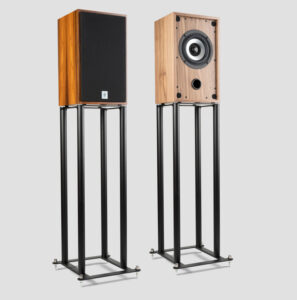Are the Marlow and Greenwich BBC-licensed loudspeakers?
No.
They draw on the BBC’s open-source research into cabinet materials but are not based on BBC designs. Officially-licensed BBC speakers were developed for the UK broadcaster’s specific monitoring requirements in the 1970s and they have to conform very strictly to the original design specification.
Because EJ Jordan are not a licensee, we are free to refine the cabinets and bring them thoroughly up-to-date. In addition, the EJ Jordan Eikona wideband drive unit was developed almost 50 years after the original BBC designs. Each cabinet is designed and tuned specifically to the Eikona.
Why use two Eikonas rather than a separate bass in the Greenwich?
A suitable bass driver would not have the ultra-lightweight cone of the Eikona, so it would not achieve the same speed of transients or purity of detail. Adding a second Eikona extends the power-handling capability whilst retaining the Marlow’s natural sound.
Don’t two wideband drivers interfere with each other?
The Eikonas are more directional at HF than a conventional dome tweeter. This in itself helps reduce interference between the two drivers. In addition, there is a small amount of response-shaping applied to the lower driver to reduce its output at HF.
Isn’t this the same as using a crossover?
Not at all. the component used does not sit directly in the signal path and there is no phase-distorting separation between the two drivers. Both drivers receive the same signal with just the lower driver being filtered.
What is the equalisation circuit in the Marlow EV
This is a simple circuit which balances the frequency response above 500 Hz or so. It reduces the amount of upp-midrange and treble energy the speakers put out into the room and makes the sound better-balanced. It gives the sound a more solid foundation, enabling the Marlow EV to sound like a more substantial monitor and bringing its sound into line with the Greenwich.
Are your loudspeakers better with a valve (tube) or solid-state amplifier?
We have tested them with home theatre receivers, 200 watt per channel Class-D amplifiers and a 4.5-watt triode amplifier and they sounded magnificent with them all. The better the amplifier, the better our speakers will sound. The lack of crossovers mean that both designs provide an easy load for any amplifier.
What power output does my amplifier need?
This is a tricky one to answer. To a certain extent it depends upon size of room, type of music and preferred volume. But the type of amplifier can come into play too; a valve (tube) amplifier has softer clipping characteristics than solid state, so a smaller amplifier may work unexpectedly well.. We recommend solid state amplifiers from 20 W per channel but the Marlows, in particular, have worked extremely well with 4.5 W per channel triode (tube) amplifier.
Are your loudspeakers suited to all types of music?
In testing, it was used to reproduce orchestra, bass-heavy rock and solo acoustic music. Our loudspeakers will play music naturally, with a big, accurate stereo image. They work well in home cinema systems but for maximum home theatre effect (and to be thoroughly satisfying on reggae, dub and the deepest organ music) we recommend adding a good subwoofer or two. The Greenwich was designed specifically to fulfil requests for a larger version of the Marlow, suitable for bigger rooms.
Are the Marlow and Greenwich intended for analogue or digital systems?
EJ Jordan loudspeakers are an accurate window into whatever source you use, whether analogue from a turntable or digital via a streaming service. The better the source material, the better they will sound.
Can the Marlows be used on bookshelves?
They can and may work well but for best results we recommend floor stands, ideally open frame such as the ones we have designed. Once on stands, the Marlows are remarkably tolerant of room position and work well close to walls, if required.
Can they be used near to walls?
The Marlow and Greenwich both have a well-damped bass system, aiming for a fast transient response rather than an over-extended bass. They work equally well near walls and farther out into the room. As ever, it often depends on the room so experimenting is worthwhile.
Can the standard Marlow be fitted with binding posts instead of sockets?
We find the high quality sockets fitted are superior and more reliable than most types of binding post. The exception is the Tom Evans pure copper post, as fitted to the Marlow EV and Greenwich. If required we do have high quality double 4 mm speaker plugs available for purchase which match well with the sockets and require no soldering.


